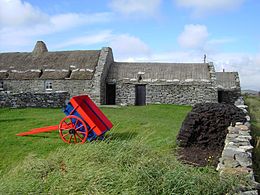Croft (land)
This article includes a list of generalreferences,butit lacks sufficient correspondinginline citations.(November 2022) |

Acroftis a traditionalScottishterm for afencedorenclosedarea of land, usually small andarable,and usually, but not always, with a crofter'sdwellingthereon. Acrofteris one who hastenureand use of the land, typically as atenant farmer,especially in rural areas.
Etymology
[edit]The wordcroftisWest Germanicin etymology, derived from theDutchtermkroftorkrochtand theOld Englishcroft,meaning an enclosed field.[1]Today, the term is used most frequently inScotland,most crofts being in theHighlands and Islandsarea. Elsewhere the expression is generallyarchaic.InScottish Gaelic,it is renderedcroit(pronounced[kʰɾɔʰtʲ],pluralcroitean[ˈkʰɾɔʰtʲən]).
Legislation in Scotland
[edit]The Scottish croft is a small agricultural landholding of a type that has been subject to special legislation applying to theScottish Highlandssince 1886.[2]The legislation was largely a response to the complaints and demands oftenantfamilies who were victims of theHighland Clearances.The modern crofters ortenantsappear very little in evidence before the beginning of the 18th century. They were tenants at will underneath thetacksmanandwadsetters,but practically their tenure was secure enough. The first evidence that can be found of small tenants holding directly of theproprietoris in a rental of the estates of Sir D. MacDonald inSkyeandNorth Uistin 1715.[3]
The first planned crofting townships in the Outer Hebrides were Barragloum and Kirkibost (Great Bernera) which were laid out into 32 large "lots" of between 14 and 30 acres in the uniform rectangular pattern that would become very familiar in later decades. This work was carried out in 1805 by James Chapman for the Earl of Seaforth.
The first edition of the Ordnance Survey in 1850 clearly highlights the division of this land and the turf and stone boundaries built by the first tenants in 1805 are still in use today as croft boundaries. Kirkibost was 'cleared' of its tenants in 1823 and the 1850 mapping clearly shows roofless ruins on each parcel of land. The township was however re-settled in 1878 following the Bernera Riot four years earlier using exactly the same division boundaries set out in 1805.[3]
TheParliament of the United Kingdomcreated theCrofters' Act 1886,after theHighland Land Leaguehad gainedseatsin that parliament. The government was thenLiberal,withWilliam Ewart Gladstoneas Prime minister. Another Crofters' Act was created in 1993 (the Crofters' (Scotland) Act 1993). The earlier Act established the firstCrofting Commission,but its responsibilities were quite different from those of the newerCrofters Commissioncreated in 1955. The Commission is based inInverness.[3]
Crofts held subject to the provisions of the Crofters' Acts are in theadministrative countiesofShetland,Orkney,Caithness,Sutherland,Ross-shire,Inverness-shire andArgyll,in the north and west of Scotland. Under the 1886 legislation (theCrofters' Holdings (Scotland) Act) protected crofters are members of a crofters'township,consisting of tenants of neighbouring crofts with a shared right to usecommonpasture.Since 1976 it has been legally possible for a crofter to acquire title to his croft, thus becoming anowner-occupier.[3]
TheLand Reform (Scotland) Act 2003gives crofters the right to buy their land.
See also
[edit]References
[edit]This article incorporates text fromDwelly's[Scottish] Gaelic Dictionary(1911).(Croitear)
- ^Simpson, J.A.; Weiner, Edmund S.C., eds. (1989). "Croft".Oxford English Dictionary(2nd ed.). Oxford: Clarendon.ISBN9780198611868.
- ^Chambers, W.R., ed. (1901)."Crofter".Chambers's Encyclopaedia.Vol. 3 (revised ed.). p. 575.Retrieved25 February2023.
- ^abcdMacDonald, L. (1886).The Past and Present Position of the Skye Crofters.Glasgow: Bell and Bain Printers.JSTOR60245142.
